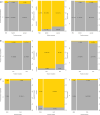The off-label uses of pipeline embolization device for complex cerebral aneurysms: Mid-term follow-up in a single center
- PMID: 36583531
- PMCID: PMC12035148
- DOI: 10.1177/15910199221148800
The off-label uses of pipeline embolization device for complex cerebral aneurysms: Mid-term follow-up in a single center
Abstract
ObjectiveTo describe the off-label uses of pipeline embolization device for a variety of types of aneurysms including ruptured aneurysms, posterior circulation aneurysms, small aneurysms, distal aneurysms, and recurrent aneurysms.MethodsClinical and angiographic data of patients who underwent pipeline embolization device treatment on off-label use at our center were retrospectively reviewed. For categorical variables, Fisher's exact test was used, and a two-sample Wilcoxon rank-sum test was used for patients' age to analyze the correlation with outcomes.ResultsIn this study, 121 aneurysms in 107 patients received off-label pipeline embolization device treatments. The overall rate of complete aneurysm occlusion was 77.8% (28/36 in 35 patients) for posterior circulation aneurysms and 95.3% (81/85 in 72 patients) for anterior circulation aneurysms. The posterior circulation aneurysms have a lower rate of aneurysm occlusion (p = 0.0372). The small aneurysms have a higher rate of aneurysm occlusion (p = 0.0104). The patient's sex, age, and aneurismal size were associated with ischemic stroke complications (p = 0.0397, 0.0166, and 0.0178). In posterior circulation aneurysm patients, only two basilar apex aneurysms underwent pipeline embolization device treatment, both of whom died of thrombotic complications. There was no difference in mortality between posterior circulation aneurysm patients (8.6%, 3/35) and anterior circulation aneurysm patients (1.4%, 1/72) (p = 0.1015). Patients of older age have a higher risk of death rate (p = 0.0053).ConclusionsThe off-label use of pipeline embolization device is often performed in clinical practice and can achieve efficacy in complex aneurysms. The off-label use of pipeline embolization device was found to carry an increased rate of mortality in older patients. Excluding basilar apex aneurysms, the pipeline embolization device is as safe as anterior circulation aneurysms in the treatment of posterior circulation aneurysms elsewhere.
Keywords: Pipeline embolization device; cerebral aneurysm; endovascular; off-label.
Conflict of interest statement
Declaration of conflicting interestsThe author(s) declared no potential conflicts of interest with respect to the research, authorship, and/or publication of this article.
Figures








Similar articles
-
Safety and efficacy profile of off-label use of the Pipeline Embolization Device: A systematic review and meta-analysis.J Stroke Cerebrovasc Dis. 2024 Apr;33(4):107586. doi: 10.1016/j.jstrokecerebrovasdis.2024.107586. Epub 2024 Jan 17. J Stroke Cerebrovasc Dis. 2024. PMID: 38242183 Free PMC article.
-
Outcomes After Off-Label Use of the Pipeline Embolization Device for Intracranial Aneurysms: A Multicenter Cohort Study.World Neurosurg. 2018 Jul;115:e200-e205. doi: 10.1016/j.wneu.2018.04.012. Epub 2018 Apr 19. World Neurosurg. 2018. PMID: 29679782
-
Treatment of giant intracranial aneurysms using the Pipeline flow-diverting stent: Long-term results from the International Retrospective Study of the Pipeline Embolization Device (IntrePED) study.Interv Neuroradiol. 2024 Apr;30(2):218-226. doi: 10.1177/15910199221123282. Epub 2022 Sep 27. Interv Neuroradiol. 2024. PMID: 36168255 Free PMC article.
-
Off-label uses of the Pipeline embolization device: a review of the literature.Neurosurg Focus. 2017 Jun;42(6):E4. doi: 10.3171/2017.3.FOCUS1742. Neurosurg Focus. 2017. PMID: 28565978 Review.
-
[Midterm and long-term angiographic outcomes and efficacy analysis of the Pipeline Embolization Device in the treatment of intracranial aneurysms].Zhonghua Wai Ke Za Zhi. 2024 Dec 1;62(12):1113-1119. doi: 10.3760/cma.j.cn112139-20240613-00293. Zhonghua Wai Ke Za Zhi. 2024. PMID: 39606995 Chinese.
Cited by
-
Safety and efficacy profile of off-label use of the Pipeline Embolization Device: A systematic review and meta-analysis.J Stroke Cerebrovasc Dis. 2024 Apr;33(4):107586. doi: 10.1016/j.jstrokecerebrovasdis.2024.107586. Epub 2024 Jan 17. J Stroke Cerebrovasc Dis. 2024. PMID: 38242183 Free PMC article.
-
Editorial: Advances in flow-diversion devices for cerebral aneurysms.Front Neurol. 2023 Jul 4;14:1195367. doi: 10.3389/fneur.2023.1195367. eCollection 2023. Front Neurol. 2023. PMID: 37470007 Free PMC article. No abstract available.
-
Flow diversion of cerebral aneurysms in Type I osteogenesis imperfecta: A case report of the first two treatments in humans.SAGE Open Med Case Rep. 2024 Aug 24;12:2050313X241274243. doi: 10.1177/2050313X241274243. eCollection 2024. SAGE Open Med Case Rep. 2024. PMID: 39185069 Free PMC article.
-
Anterior choroidal artery aneurysm case series: a clinical decision algorithm for endovascular and surgical treatment using a novel classification system.Neurosurg Rev. 2024 Dec 18;47(1):905. doi: 10.1007/s10143-024-03152-y. Neurosurg Rev. 2024. PMID: 39692873
-
Changes in blood biochemistry thrombosis parameters 24 hours after stent-assisted endovascular treatment of intracranial aneurysms.Interv Neuroradiol. 2024 Aug 8:15910199241272522. doi: 10.1177/15910199241272522. Online ahead of print. Interv Neuroradiol. 2024. PMID: 39113620 Free PMC article.
References
-
- Cler SJ, Lauzier DC, Chatterjee ARet al. et al. Comparative study of on-label versus off-label treatment of intracranial aneurysms with the pipeline embolization device. J Neurosurg 2022 Jan 28; 1–6. - PubMed
-
- Patel PD, Chalouhi N, Atallah Eet al. Off-label uses of the pipeline embolization device: a review of the literature. Neurosurg Focus 2017; 42: E4. - PubMed
-
- Vakharia K, Munich SA, Waqas Met al. et al. Treatment of anterior circulation aneurysms in the internal carotid artery with flow diverters. Neurosurgery 2020; 86: S55–S63. - PubMed
-
- Lv X, Chen Z, Liu Let al. et al. Rupture of intradural giant aneurysms: the mode of treatment, anatomical, and mechanical factors. Neurol India 2019; 67: 1194–1199. - PubMed
-
- Lv X, Ge H, He Het al. et al. A systematic review of pipeline embolization device for giant intracranial aneurysms. Neurol India 2017; 65: 35–38. - PubMed
MeSH terms
LinkOut - more resources
Full Text Sources
Medical
Miscellaneous

